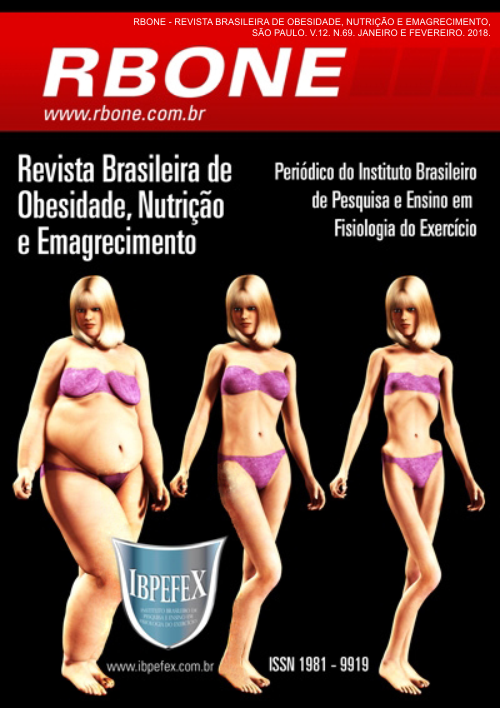Nutritional intervention through culinary workshops and educational lectures: application and influence in nutritional status of adults
Abstract
The aim of this study was to evaluate the nutritional status of clients served by the Nutrition Assistance Center (NAC) of the State University of Minas Gerais (UEMG), Passos Unit; To perform nutritional intervention through culinary workshops and educational lectures, to evaluate the effectiveness of anthropometric measurements and percentage of body fat. This is an intervention study. The nutritional status was evaluated by Body Mass Index (BMI), abdominal circumference (AC) and percentage of body fat (%F). The culinary workshops involved the preparation of oatmeal, zucchini lasagna, feijoada light, energy juice, sugar free coconute chocolate, winter cream, healthy mousse, nutritious pancake and salt-flavored seasoning. The lectures dealt with topics such as "healthy eating and quality of life", "myths and truths about food and nutrition", "Diet and light", "Quality starts at the supermarket". Descriptive statistics and the matched T-Stundent test were performed to verify the effectiveness of the nutritional intervention. The level of significance was 5%. Thirty-five individuals, aged 37 ± 18 years, 91% female, participated in the study. There was a significant reduction in abdominal circumference (t = 2.255, p = 0.035) and body %F (t = 2,434; p = 0.026) after nutritional intervention. The results suggest that the nutritional intervention contributed to the reduction of AC and %F.
References
-ABESO. Associação para o Estudo da Obesidade e da Síndrome Metabólica. Diretrizes Brasileiras de Obesidade 2009/2010. 3ªedição. Ac Farmacêutica. 2009.
-Bonifácio, B. S.; Oliveira, N. C.; Portes, L. A.; Gomes, E. P. Prevalência de sobrepeso e obesidade em adolescentes da Zona Sul de São Paulo. Educação Física em Revista. Vol. 8. Num. 1. p. 54-59. 2014.
-Brasil. Ministério da Saúde. Vigitel Brasil 2014 Saúde Suplementar: Vigilância de fatores de risco e proteção para doenças crônicas por inquérito telefônico. Brasília. 2015.
-Campolina, A. G.; Adami, F.; Santos, J. L. F.; Lebrão, M. L. A transição de saúde e as mudanças na expectativa de vida saudável da população idosa: possíveis impactos da prevenção de doenças crônicas. Cad. Saúde Pública. Vol. 29. Núm. 6. p. 1217-1229. 2013.
-Claro, R. M.; e colaboradores. Preço dos alimentos no Brasil: prefira preparações culinárias a alimentos ultraprocessados. Cadernos de Saúde Pública. Vol. 32. Núm. 8. 2016.
-Claro, R. M.; e colaboradores. Consumo de alimentos não saudáveis relacionados a doenças crônicas não transmissíveis no Brasil: Pesquisa Nacional de Saúde, 2013. Epidemiologia e Serviços de Saúde. Vol. 24. p. 257-265. 2015.
-Foss, M. L.; Keteyian, S. J. Fox: Bases fisiológicas do exercício e do esporte. 6ª edição. Guanabara Koogan. 2000.
-Louzada, M. L. D. C.; e colaboradores. Impact of ultra-processed foods on micronutrient content in the Brazilian diet. Revista de Saúde Pública. Vol. 49. 2015.
-Malta, D. C.; e colaboradores. Tendência temporal dos indicadores de excesso de peso em adultos nas capitais brasileiras, 2006-2013. Ciência & Saúde Coletiva. Vol. 21. p. 1061-1069. 2016.
-Prates, R. E.; Silva, A. C. P. Avaliação do conhecimento nutricional e de hábitos alimentares de pacientes com doenças crônicas não transmissíveis em hospital particular no sul do Brasil. Revista da Associação Brasileira de Nutrição. Vol. 5. Num. 1. p. 21-27. 2013.
-Teixeira, P.; e colaboradores. Intervenção nutricional educativa como ferramenta eficaz para mudança de hábitos alimentares e peso corporal entre praticantes de atividade física. Ciênc. saúde coletiva. Vol. 18. p. 347-356. 2013.
-Ued, F. V.; e colaboradores. Alterações antropométricas, bioquímicas e de variáveis da síndrome metabólica entre crianças e adolescentes obesos com e sem doença hepática gordurosa não alcoólica. Rev. Médica de Minas Gerais. Vol. 25. p. 529-536. 2015.
-WHO. World Health Organization. Physical status: The use of and interpretation of anthropometry, Report of a WHO Expert Committee. 1995.
Authors who publish in this journal agree to the following terms:
- Authors retain the copyright and grant the journal the right of first publication, with work simultaneously licensed under the Creative Commons Attribution License BY-NC which allows the sharing of the work with acknowledgment of the authorship of the work and initial publication in this journal.
- Authors are authorized to enter into additional contracts separately for non-exclusive distribution of the version of the work published in this journal (eg, publishing in institutional repository or book chapter), with acknowledgment of authorship and initial publication in this journal.
- Authors are allowed and encouraged to post and distribute their work online (eg, in institutional repositories or on their personal page) at any point before or during the editorial process, as this can bring about productive change as well as increase impact and impact. citation of published work (See The Effect of Free Access).






